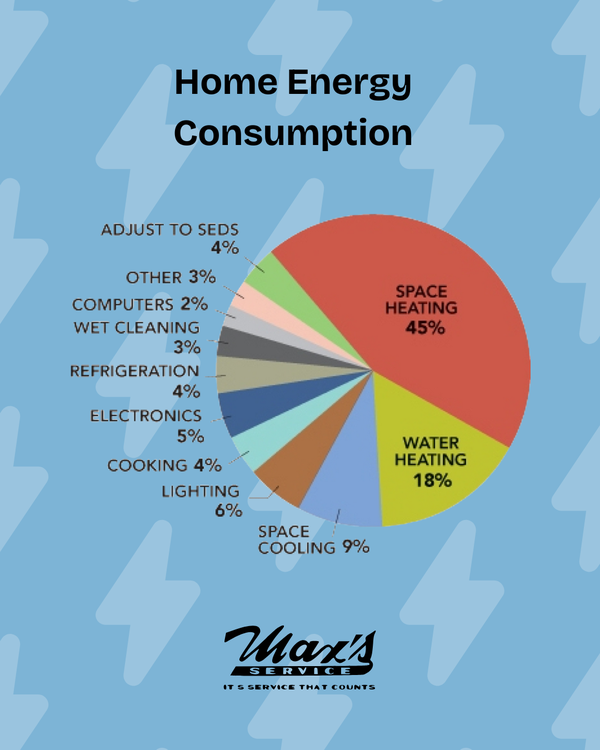
It takes a lot to keep the lights on, your phone charged, and your family on the move. Michigan utility costs rise almost every year, and with the state approving significant rate increases for Consumers Energy and DTE Energy in 2025, your monthly utility bill will go up. Find out how big a role the energy consumption of household appliances plays in your monthly expenses, plus ways to save.
Your appliances play a relatively small role in total household energy consumption. The majority of gas and electricity use in most households goes to heating and cooling, and that’s more pronounced in colder climates (welcome to northern Michigan!) that require several months of heating.
According to the Department of Energy, space heating, water heating, and space cooling comprise the largest shares of energy consumption in US homes:
Most home appliances are lumped into smaller, more specific categories, such as cooking (4%), refrigeration (4%), and wet cleaning (3%). While these are smaller contributors to overall energy consumption, appliance energy costs are some of the most affordable to offset or reduce through upgrades and strategic use.
The exact amount of energy used by your household appliances varies based on the age and efficiency of the equipment, the frequency and duration of use, the size, and the settings used during operation.
Of course, most of us don’t really measure energy use in kilowatt hours; we measure it in the rate we actually pay for that power. We broke down the average appliance energy costs by type to illustrate how much each piece of equipment adds to your bill.
Read more: Energy Efficient Appliances Have Come a Long Way
Using baseline usage and normal equipment sizes and settings, we calculated the estimated monthly cost of your favorite home appliances.
Both gas and electric dryers are very energy-intensive because they generate heat. Dryers cost between $8 and $25 per month, depending on the fuel source, frequency of use, and age of the equipment.
Not accounting for using the self-cleaning feature, electric ovens cost approximately $2-$5 per month. Microwave and convection ovens use less energy than your full-sized range, so use those smaller appliances whenever possible to save a few bucks.
Combination refrigerator/freezer units are the largest single source of electricity consumption in the kitchen and much of the home. A standard 17.5 cubic feet unit will use over 150 kWh per month, adding about $15-$25 to your energy bill.
When you use cold water, washing machines require surprisingly little energy. Their monthly electricity draw is less than 10 kWh, which translates to about $1-$3. If you use warm water, you can expect significantly higher costs.
Read our complete guide to washing machine settings to maximize your cleaning and minimize your costs!
Grab your calculator to find your annual energy use.
1. First, find your daily energy use by checking your meter. Then, toss those numbers into this formula:
(Wattage × Hours Used Per Day) ÷ 1000 = Daily Kilowatt-hour (kWh) consumption
2. Then, multiply that total by 365 days:
Daily kWh consumption × number of days used per year = annual energy consumption
3. To find the annual cost to run all the appliances in your home, complete the calculation by plugging in your yearly utility rate.
Annual energy consumption × utility rate per kWh = yearly cost to run appliances.
You can also use this handy calculator from Energy.gov.
Northern Michigan residents have trusted Max’s for a wide selection of appliances and professional repair for generations. Our team goes above and beyond to provide quality work and honest recommendations, helping our customers enjoy reliable, energy-efficient appliances for years to come. For more ways to lower your appliance energy consumption, or to start your appliance search, contact our friendly team today!
Share on Twitter Share on Facebook
2025
2024
2023
2022
2021
2020
2017
Comments
There are currently no comments
New Comment